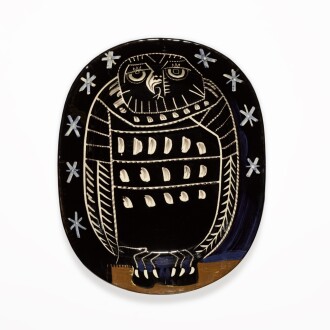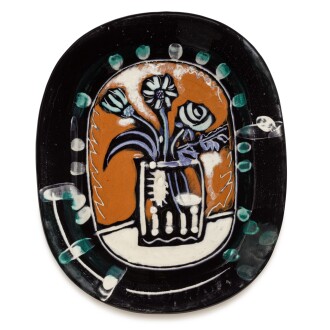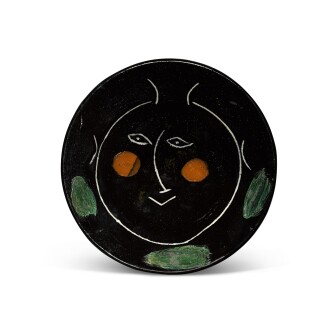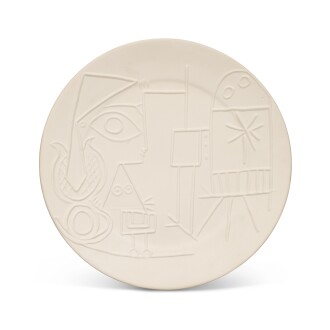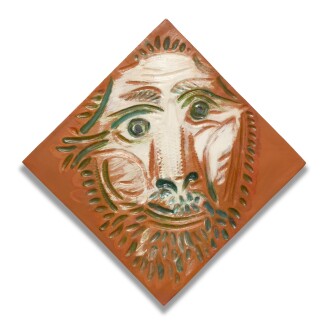S otheby’s London’s Important Picasso Ceramics auction explores the artist’s productive years in the French Riviera with a survey of vibrant and whimsical clay creations he crafted in sunny Vallauris. Open for bidding online from 3–12 May, the sale includes an array of Picasso’s playful and practical editioned ceramics, as well as a selection of gold medallions and one of his much sought-after silver plates. Additional highlights include a variety of ceramics from the esteemed Nina Miller Collection.
Auction Highlights
Background
In 1946 while vacationing with his lover Françoise Gilot at Golfe-Juan in the South of France, Picasso met Georges and Suzanne Ramié, the owners of the Madoura pottery studio in the nearby town of Vallauris. The Ramiés welcomed Picasso into their workshop where the artist created three ceramic objects, a head of a faun and two bulls. While Picasso had experimented with clay almost 40 years earlier, this encounter at Madoura so captivated his interest that the artist returned a year later, sketches in hand and his head brimming with ideas. He began working at Madoura daily, completing over 1,000 unique pieces between 1947 and 1948. This was the start of a friendship and creative partnership with the Ramiés that would last until Picasso’s death.
Acknowledging the inherently serial nature of pottery production, Picasso and the Ramiés decided to make multiples of his ceramics that would be sold at Madoura. By this time Picasso was a world-renowned artist, and being well aware of his fame, he wanted to make his work more accessible. “I would like them to be found in every market, so that, in a village in Brittany or elsewhere, one might see a woman going to the fountain to fetch water with one of my jars.” And so, between 1947 and 1971, Picasso designed 633 different ceramic works that were to be made in editions of 25 to 500.
Edition Picasso
Dense, but pliable, clay offered Picasso endless freedom of expression. Enamoured by the playful medium, he explored a variety of ceramic techniques over three decades at the Madoura Pottery in Vallauris. Together with workshop owners Georges and Suzanne Ramié, Picasso developed an impressive ceramic oeuvre ranging from practical bowls and ashtrays to fanciful, grand vases. Through this fruitful partnership, the artist discovered his two preferred methods of production: éditions Picasso – the process of replicating an initial design by hand alone – and eventually empreintes originales – editions incised by the artist that were then duplicated via plaster mould.
In surveying the éditions Picasso – each tellingly stamped or incised 'Edition Picasso' - one can trace the artist’s early mastery of the ceramic medium. He developed his personal style through trial and error, and quickly learned he preferred building by hand to wrestling with the wheel. He was bold but meticulous in his approach, being careful to round each pitcher and square each tile off just so before adding surprising flourishes, from luxurious slips and glazes to quirky handles. Even the expert potters at Madoura struggled to keep up with the prolific artist, who gracefully hand-crafted prototypes for sought after pieces such as Poissons (A. R. 113) (Lot 6) and Lampe femme (A. R. 295) (Lot 17) with ease.
Empreinte originale
In 1949, taking their inspiration from printmaking, Picasso and the Ramiés developed a method of producing editioned ceramics known as empreinte originale. To complete this process: a plaster mould was made of a plate, bowl or vase; once this had hardened, Picasso would carve into or model onto the material to delineate an image. A sheet of prepared clay was then pushed down into the mould to take an impression of the design. Picasso’s compositions thus appeared in reverse – his incised lines became areas of relief, as in Quatre profils enlaces (A. R. 87) (Lot 4) and Jacqueline au chevalet (A. R. 335) (Lot 24), while relief that had been added to the mould resulted in engraved voids and recesses.
From the mid-1950s, Picasso began to leave some of his large empreintes undecorated by glazes or slips – these were called the pâtes blanches. Georges Ramié described this series of works as follows: ‘white or pink biscuit-fired earthenware, engraved in relief, preserving all the freshness they possessed as they were removed from the matrix, without being worked over. In this way they satisfy sculpture’s need for light, which alone can provide it with truth and life.’ (McCully, p. 33).



